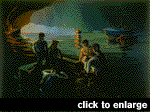





Normandy Summer 1944 |

Normandy Summer, 1944: D-Day and after in Canadian Art
by Laura BrandonCanadian Military History Vol. 3, No. 1 (Spring 1994), 26-32.Canada sent twelve official war artists to France, more than one third of the thirty- two that were ultimately commissioned. They served with all three services, and as a result of their labour Canada has a remarkably complete artistic record of the Normandy campaign from the preparation stages through to the drive towards Germany. This collection is housed at the Canadian War Museum and certain paintings from it form part of the permanent displays at the Museum, while others are on loan to museums in Normandy and are used in special exhibitions in Canada. This year twenty-six of the oils will be on display at the Museum in a commemorative show, Normandy Summer. Several of the watercolours are also in 50th Anniversary loan exhibits both in Canada and across the Atlantic. The intent of this article is to act as a guide to a cross-section of the artists of the Normandy campaign by focusing on works that will be on view at the Canadian War Museum over the coming year. Reference will also be made to the watercolours that form the bulk of the Museum's artistic record of the events of 1944. The art of the Normandy campaign exemplifies three issues that influenced the creation of the works that form the Canadian War Records. The first was the requirement of the programme, as expressed in the Canadian War Artists' Committee's "Instructions for War Artists," for the work produced to be accurate "in delineation and presentation of clothing, equipment, weapons, vehicles and craft."* The second was the growing interest in modern art within the Canadian artistic community in the decades preceding the outbreak of war. The third was the ideas that were doubtless current in the Canadian artistic community of the time as to what war art should be. Many future war artists would have been familiar with a 1942 editorial by a noted art historian at Acadia University, Walter Abell, who, in the widely read Maritime Art (later to become Canadian Art), wrote, "It is well to recognize that the more formal and official war art becomes the less significant as art it is likely to be."*2 |
 | In Survivors, Normandy, off Le Havre (CWM 1 03 1 0), Anthony Law describes another tragic incident where sailors are rescued after their motor torpedo boat was severely damaged by enemy gunfire and caught fire. As a serving officer at the time (and not an official war artist) Law was only able to make brief sketches after the incident. In this composition the artist exploits colour to intensify the drama. The blue and orange shades contrast quite violently with each other and underline the seriousness of the original action and its consequences. As the artist later commented, "It's a product of my vivid imagination."*3 Three other artists depicted the Canadian Navy during the Normandy campaign: Leonard Brooks, Michael Forster and Jack Nichols. Forster produced the most modernist works of all the war artists. His Vestiges of Mulberry, Arromanches (CWM 10229) is one of a number of mixed media compositions which show his indebtedness to the newer art styles which emerged in Britain in the 1930s and found expression in their war art programme in the work of artists like Paul Nash. Nichols, too, was stimulated by artistic precedents but absorbed his influences to create powerful paintings and drawings focusing on human suffering and confusion in wartime. In Normandy Scene, Beach in Gold Area (CWM 10523), the soldiers' faces express their emotions on encountering the dislocation and misery of local families in the aftermath of battle. A piece of bleached, skeletal driftwood to the lower right evokes the presence of death. T.R. MacDonald was attached to the Army but never painted in Normandy. Nevertheless, his portrait of General Crerar (CWM 13151), who commanded the First Canadian Army in 1944, contributes to the visual history of the period and place. George Pepper was another artist attached to the Army, and his Tanks Moving Up for the Breakthrough (CWM 13795) commemorates the events of August 8 when Sherman tanks supporting the 2nd Canadian Division prepared for Operation "Totalize," an all-out attack that was intended to cut off the retreat of German forces near Falaise. The silhouette of the tanks against the brilliantly coloured sunset evokes the drama of the impending action. In this composition, historical accuracy and artistic vision are effectively combined. The Canadian War Artists' Committee's "Instructions to War Artists" was sensitive to artistic vision when it stated that war artists were "to record and interpret vividly and veraciously according to [their] artistic sense." Their works were further expected to "be worthy of Canada's highest cultural traditions, doing justice to History." Unlike the British programme, and indeed Canada's own First World War programme, the Canadian War Memorials, there seems to have been no underlying political agenda other than to record. The elements of propaganda and commemoration in the other programmes do not appear to have any counterpart in the Canadian project. The result is a body of work, particularly in the case of the Normandy campaign, whose legacy is a fair and accurate record of events, gently coloured by a sensitivity to freedom of style and opinion.
Notes* Canadian War Artists' Committee, Instructions for War Artists, March, 1943, Mark Schaefer, Ontario.*2 Walter Abell, "Canada at War," Maritime Art, February/March 1942, p.75. *3 Joan Murray, Canadian Artists of the Second World War, Oshawa: The Robert McLaughlin Gallery, 1981, p.74. (Exhibition catalogue). Back to the Top. Laura Brandon is the Curator of War Art at the Canadian War Museum. She studied Canadian Art History at Queen's University. |

    
|


